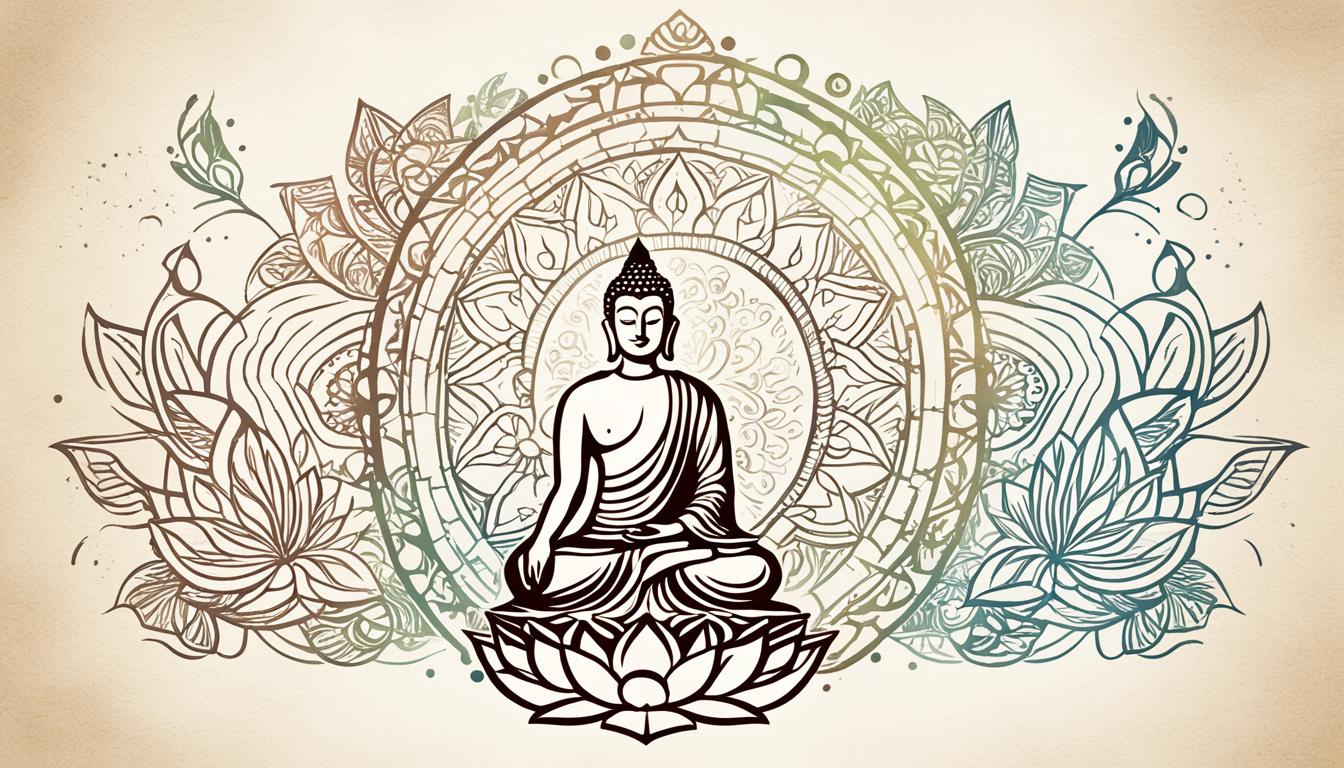“Peace comes from within. Do not seek it without.” – Buddha
Welcome to the world of Buddhism, a philosophy that explores the depths of the human mind in search of true peace and enlightenment. Buddhism offers a profound understanding of the root causes of suffering and provides a path to inner tranquility that anyone can follow.
At its core, Buddhism delves into the intricate functions of the mind, including contemplation, cognitive transformation, and compassion. By deepening the psychological analysis of the human mind, Buddhism sheds light on its relevance to the pursuit of peace.
In this article, we will explore the simple definition of Buddhism, its core teachings, beliefs and practices, the life of Buddha, types of Buddhism, and the principle of dependent origination and kamma. So, get ready to embark on an enlightening journey of self-discovery and understanding.
Key Takeaways:
- Buddhism aims to examine the human mind as the root cause of suffering.
- The Four Noble Truths form the foundation of Buddhism.
- Buddhism focuses on achieving enlightenment and inner peace through morality, meditation, and wisdom.
- Siddhartha Gautama, known as the Buddha, founded Buddhism over 2,500 years ago.
- Buddhism has different forms, such as Theravada, Mahayana, Tibetan, Zen, and Nirvana Buddhism.
The Core of Buddhism: The Four Noble Truths
In Buddhism, the Four Noble Truths serve as the fundamental teachings that lay the groundwork for understanding the essence of this ancient philosophy. These truths provide a comprehensive framework for comprehending the nature of suffering, its root causes, its cessation, and the path to overcome it.
- The Nature of Suffering: The first noble truth acknowledges the universal presence of suffering. It recognizes that suffering is an intrinsic part of human existence and extends beyond physical pain to encompass mental and emotional anguish.
- The Root Cause of Suffering: The second noble truth reveals that the root cause of suffering is craving and ignorance. Buddhism asserts that attachment and desire, fueled by ignorance of the true nature of reality, lead to suffering.
- The Cessation of Suffering: The third noble truth offers hope by proclaiming that suffering can be brought to an end. It signifies the possibility of attaining a state of liberation and freedom from the cycle of suffering.
- The Path to Overcome Suffering: The fourth noble truth outlines the Eightfold Path as the way to overcome suffering and attain enlightenment. This path encompasses elements such as Right View, Right Intention, Right Speech, Right Action, Right Livelihood, Right Effort, Right Mindfulness, and Right Concentration.
The Four Noble Truths form the bedrock of Buddhism, providing seekers with a profound understanding of the human condition and offering a pathway to liberation from suffering. By acknowledging the existence of suffering, understanding its causes, believing in its cessation, and following the path to overcome it, individuals can embark on a transformative journey towards inner peace and enlightenment.
The Eightfold Path
The Eightfold Path, which is encapsulated within the fourth noble truth, offers practical guidance for individuals seeking to walk the path towards liberation. Each aspect of the Eightfold Path plays a crucial role in cultivating wisdom, ethical conduct, and mental discipline. Here is an overview of the Eightfold Path:
| Aspect of the Eightfold Path | Description |
|---|---|
| Right View | Gaining a correct understanding of the nature of reality and the laws of karma. |
| Right Intention | Cultivating wholesome intentions and renouncing harmful desires. |
| Right Speech | Practicing truthful, kind, and harmonious speech. |
| Right Action | Engaging in actions that promote peace, compassion, and non-harm. |
| Right Livelihood | Choosing a livelihood that is ethical and contributes to the well-being of others. |
| Right Effort | Exerting effort to cultivate positive qualities and overcome unwholesome states of mind. |
| Right Mindfulness | Developing awareness and mindfulness of the body, feelings, thoughts, and phenomena. |
| Right Concentration | Cultivating deep and focused meditation to attain heightened states of concentration and insight. |
The Eightfold Path provides a comprehensive roadmap for cultivating a compassionate, wise, and ethical way of life. By integrating these principles into daily existence, individuals can deepen their understanding of themselves, alleviate suffering, and progress towards spiritual awakening.

Buddhist Beliefs and Practices
In Buddhism, the focus is not on worshipping a supreme god or deity. Instead, the religion centers around attaining enlightenment and inner peace through moral conduct, meditation, and wisdom. By cultivating these qualities, followers can achieve spiritual growth and peace of mind.
Buddhism encourages individuals to avoid extremes of self-indulgence and self-denial. It promotes a balanced approach to life, emphasizing virtues such as kindness, patience, generosity, and compassion. These principles guide followers in their interactions with others, fostering harmony and understanding.
Buddhist monks, who dedicate their lives to spiritual practice, adhere to a strict code of conduct known as the Vinaya. This code includes rules on ethical behavior, such as refraining from harming living beings and practicing celibacy. By committing to this disciplined way of life, monks exemplify the teachings of Buddhism and serve as role models for others.
The Five Precepts
Central to Buddhist ethical conduct are the Five Precepts, guidelines for moral behavior that lay Buddhists strive to follow:
Panatipata veramani sikkhapadam samadiyami. I undertake the precept to refrain from taking life.
Adinnadana veramani sikkhapadam samadiyami. I undertake the precept to refrain from taking what is not given.
Kamesu micchacara veramani sikkhapadam samadiyami. I undertake the precept to refrain from sexual misconduct.
Musavada veramani sikkhapadam samadiyami. I undertake the precept to refrain from false speech.
Suramerayamajja pamadatthana veramani sikkhapadam samadiyami. I undertake the precept to refrain from intoxicants that cloud the mind.
By following these precepts, practitioners seek to create a foundation of morality and integrity in their lives, leading to greater peace of mind and harmonious relationships with others.

Buddhist Meditation Practices
Meditation is a fundamental practice in Buddhism, enabling individuals to cultivate mindfulness and develop a deeper understanding of reality and their own minds. Various meditation techniques are employed, such as:
- Mindfulness meditation (Satipatthana), which involves focusing one’s attention on the present moment, observing thoughts and sensations without judgment.
- Loving-kindness meditation (Metta), which cultivates feelings of goodwill and compassion towards oneself and others.
- Vipassana meditation, a practice that involves the observation and investigation of the impermanent and selfless nature of all phenomena.
Through regular meditation practice, Buddhists learn to free themselves from attachments and cravings, gaining insight into the nature of existence and developing greater clarity and equanimity.
Achieving Inner Peace and Enlightenment
Ultimately, Buddhism offers a path to inner peace and enlightenment. By following the teachings, practicing meditation, and embodying moral conduct, individuals can transform their minds, alleviate suffering, and attain a state of liberation called Nirvana.
| Key Beliefs and Practices in Buddhism | Description |
|---|---|
| The Three Refuges | The Buddha, the Dharma (teachings), and the Sangha (community of practitioners) are the three central refuges in Buddhism. |
| Karma | The law of cause and effect, where one’s actions have moral consequences that shape future experiences. |
| Rebirth and Reincarnation | Buddhism believes in the cycle of birth, death, and rebirth, with individuals having multiple lives to progress spiritually. |
| Enlightenment | The ultimate goal in Buddhism, characterized by the complete cessation of suffering and the realization of one’s true nature. |
| Middle Way | The path of moderation and avoiding extremes, which leads to a balanced and harmonious life. |
| Bodhisattva Ideal | The aspiration to attain enlightenment for the benefit of all beings, delaying one’s own liberation until all others are freed from suffering. |
By understanding Buddhism’s beliefs and incorporating its practices into your life, you can cultivate peace, wisdom, and compassion, bringing harmony to yourself and those around you.
The Life of Buddha and the Origins of Buddhism
Siddhartha Gautama, later known as the Buddha, is the central figure in Buddhism. He laid the foundation of this ancient spiritual tradition around 2,500 years ago in India. Seeking truth and peace, he renounced his life of luxury in search of a deeper understanding of human suffering.
After years of intense spiritual exploration, the Buddha achieved enlightenment while meditating under a Bodhi tree. This profound realization marked the culmination of his quest and inspired him to share his insights with others. The Buddha’s teachings, known as the Dharma, form the core principles of Buddhism and offer a pathway to liberation from suffering.
Throughout his life, the Buddha traveled extensively, imparting his teachings to people from all walks of life. His compassionate guidance influenced countless individuals, fostering spiritual growth and awakening. The wisdom and teachings of the Buddha continue to inspire and resonate with seekers of inner peace and enlightenment to this day.

The life story of the Buddha serves as a profound example of spiritual awakening and the potential for transformation. It embodies the essence of Buddhism—simplifying complex concepts and making them accessible to all who seek peace, wisdom, and liberation.
The Life of Buddha in Brief:
| Birth Name | Siddhartha Gautama |
|---|---|
| Birth Year | Circa 563 BCE |
| Became the Buddha | Age 35 |
| Enlightenment | Under a Bodhi tree |
| Teaching Duration | Over 40 years |
| Passing | 483 BCE |
Types of Buddhism
When exploring Buddhism, it’s essential to understand that this ancient philosophy has evolved and taken different forms across various regions. Each type of Buddhism offers unique perspectives and practices, contributing to the richness and diversity of Buddhist traditions worldwide. Let’s take a closer look at some of the major forms of Buddhism:
Theravada Buddhism
Regions: Thailand, Sri Lanka, Southeast Asian countries
Theravada Buddhism, also known as the “Way of the Elders,” focuses on the early teachings of the Buddha. It places great emphasis on meditation, mindfulness, and the attainment of individual enlightenment. Practitioners follow a disciplined monastic lifestyle and seek to follow the original teachings closely.
Mahayana Buddhism
Regions: China, Japan, East Asian countries
Mahayana Buddhism, known as the “Great Vehicle,” emphasizes compassion and the aspiration to help all living beings achieve enlightenment. It places importance on the Bodhisattva ideal, where individuals dedicate themselves to the welfare of others. Mahayana teachings also include the concepts of emptiness and the interdependence of all phenomena.
Tibetan Buddhism
Regions: Tibet, Nepal, parts of Russia
Tibetan Buddhism incorporates elements of Mahayana Buddhism and ancient Tibetan beliefs. It places significant importance on spiritual leaders known as Tibetan Lamas, who guide practitioners on their spiritual path. Tibetan Buddhism is renowned for its intricate rituals, chanting, and the practice of tantra.
Zen Buddhism
Regions: Japan, United States, worldwide
Zen Buddhism, also known as Chan Buddhism, emphasizes mindfulness, meditation, and direct experience over the study of scriptures. It encourages practitioners to live in the present moment and seek insight through silent meditation and contemplation. Zen Buddhism values simplicity and direct transmission from master to student.
Nirvana Buddhism
Regions: Primarily in Japan
Nirvana Buddhism, or Pure Land Buddhism, focuses on the pursuit of enlightenment, particularly through the devotion to Amitabha Buddha. Practitioners aspire to be reborn into Amitabha’s Pure Land, a realm conducive to attaining Nirvana. This form of Buddhism emphasizes the recitation of Amitabha Buddha’s name as a means to gain merit and rebirth in the Pure Land.

| Type of Buddhism | Regions |
|---|---|
| Theravada Buddhism | Thailand, Sri Lanka, Southeast Asian countries |
| Mahayana Buddhism | China, Japan, East Asian countries |
| Tibetan Buddhism | Tibet, Nepal, parts of Russia |
| Zen Buddhism | Japan, United States, worldwide |
| Nirvana Buddhism | Primarily in Japan |
The Principle of Dependent Origination and Kamma
In Buddhism, the understanding of the interconnectedness of all things is a fundamental concept. This principle is known as dependent origination. It teaches that everything in the universe is governed by the law of cause and effect. By recognizing and embracing this universal truth, one can gain a deeper understanding of the nature of existence and their place within it.
Kamma, another significant concept in Buddhism, refers to intentional actions and their moral consequences. It is the recognition that our actions have an impact not only on ourselves but also on others and the world around us. By cultivating mindfulness and making conscious choices, you can shape your own future and contribute to the well-being of others.
Understanding the principle of dependent origination and kamma empowers individuals to take responsibility for their actions and the consequences that follow. It highlights the importance of ethical behavior and the potential for personal growth and transformation. By living with intention and compassion, you can move closer to achieving Nirvana, a state of ultimate liberation and enlightenment.
The Law of Cause and Effect
The law of cause and effect, as explained in Buddhism, illustrates the interconnectedness of all phenomena in the universe. Just as a ripple in a pond expands and affects the entire body of water, our actions create a ripple effect that impacts ourselves and the world around us.
For example, acts of kindness and generosity can create positive outcomes, not only for the recipient but also for the giver. Conversely, actions rooted in ignorance, greed, or hatred generate negative consequences that perpetuate suffering.
| Dependent Origination | Kamma |
|---|---|
| – The principle of interconnectedness – Demonstrates the cause and effect relationship – Explains the nature of existence | – Refers to intentional actions – Considers moral consequences – Emphasizes personal responsibility |
Taking Control of Your Destiny
Understanding the principle of dependent origination and kamma enables you to take control of your destiny. By recognizing that your actions shape your future, you can make conscious choices that align with your values and aspirations.
- Reflect on your thoughts, words, and actions.
- Cultivate mindfulness to be aware of the intentions behind your actions.
- Practice ethical behavior, treating others with kindness and compassion.
- Take responsibility for the consequences of your actions.
By embracing the principle of dependent origination and living in accordance with the principles of kamma, you can walk the path towards liberation and enlightenment.
Conclusion
Buddhism, with its simple definition of examining the human mind as a root cause of suffering and offering a path to inner peace, provides invaluable insights for personal and societal harmony. By understanding the nature of suffering and its causes, individuals can embark on a journey towards inner peace and happiness.
Central to Buddhism is the development of wisdom, compassion, and mindfulness. Through meditation and self-reflection, practitioners strive to deepen their understanding of the mind and cultivate compassion towards themselves and others. Buddhism teaches that by embracing moral conduct and ethical principles, individuals can contribute to a more harmonious society.
Buddhism is not just a religion but a philosophy and a way of life. It encourages individuals to take responsibility for their own well-being and progress towards enlightenment. By following the teachings of Buddha and practicing meditation, one can gain insight into the true nature of existence and find liberation from suffering.
In summary, Buddhism offers a profound and practical path towards inner peace and self-discovery. Through its teachings on the nature of suffering and the cultivation of wisdom and compassion, it provides a roadmap for personal growth and societal harmony. Embracing Buddhism means embarking on a transformative journey towards enlightenment and living a life of mindfulness, compassion, and contentment.
FAQ
What is Buddhism?
Buddhism is a philosophy and way of life that aims to examine the human mind as the root cause of suffering and offers a path to inner peace. It emphasizes contemplation, cognitive transformation, and compassion as practices to attain non-dualistic peace.
What are the Four Noble Truths?
The Four Noble Truths are the foundational teachings of Buddhism. They explain the nature of suffering, the root cause of suffering, the cessation of suffering, and the path to overcome suffering. Buddhism teaches that suffering arises from craving and ignorance and can be overcome through wisdom, ethical conduct, and mental discipline.
Does Buddhism believe in a god or deity?
No, Buddhism does not acknowledge a supreme god or deity to worship. Instead, it focuses on achieving enlightenment and inner peace through morality, meditation, and wisdom. Buddhism emphasizes virtues such as kindness, patience, generosity, and compassion.
Who founded Buddhism?
Siddhartha Gautama, later known as the Buddha, founded Buddhism around 2,500 years ago in India. He renounced his life of luxury and embarked on a spiritual quest for truth and peace. After attaining enlightenment while meditating under a Bodhi tree, he spent the rest of his life teaching others about the path to enlightenment.
Are there different forms of Buddhism?
Yes, Buddhism has different forms in different regions. Theravada Buddhism is prevalent in Thailand, Sri Lanka, and other Southeast Asian countries. Mahayana Buddhism is practiced in China, Japan, and other East Asian countries. Tibetan Buddhism is prominent in Tibet, Nepal, and parts of Russia. Zen Buddhism emphasizes meditation and simplicity, while Nirvana Buddhism focuses on achieving a state of enlightenment.
What is the principle of dependent origination and kamma in Buddhism?
Buddhism teaches that everything in the universe is interconnected and governed by the law of cause and effect. Dependent origination is the principle that explains these interconnections. Kamma refers to intentional actions and their moral consequences. According to Buddhism, individuals are responsible for their own happiness and misery through their actions, and understanding kamma empowers them to shape their future and strive towards enlightenment.
What does Buddhism offer for personal and societal harmony?
Buddhism offers insights for personal and societal harmony by addressing the nature of suffering, the path to inner peace, and the principles of moral conduct. It emphasizes the development of wisdom, compassion, and mindfulness. Buddhism encourages individuals to take responsibility for their own well-being and strive for enlightenment.

